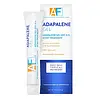What's inside
What's inside
 Key Ingredients
Key Ingredients

 Benefits
Benefits

 Concerns
Concerns

 Ingredients Side-by-side
Ingredients Side-by-side

Water
Skin ConditioningButylene Glycol
HumectantGlycerin
HumectantIsononyl Isononanoate
EmollientDiisostearyl Malate
EmollientPEG-20 Methyl Glucose Sesquistearate
EmulsifyingPhenoxyethanol
PreservativeAcrylates/C10-30 Alkyl Acrylate Crosspolymer
Emulsion StabilisingDipotassium Glycyrrhizate
HumectantChlorphenesin
AntimicrobialBisabolol
MaskingXanthan Gum
EmulsifyingPotassium Hydroxide
BufferingRetinyl Palmitate
Skin ConditioningDisodium EDTA
Helianthus Annuus Seed Oil
EmollientAloe Barbadensis Leaf Juice
Skin ConditioningMaltodextrin
AbsorbentPolysorbate 20
EmulsifyingCaprylic/Capric Triglyceride
MaskingHydroxypropyl Cyclodextrin
MaskingRetinol
Skin ConditioningPotassium Sorbate
PreservativeSodium Benzoate
MaskingSodium Metabisulfite
AntioxidantTocopherol
AntioxidantBHT
AntioxidantWater, Butylene Glycol, Glycerin, Isononyl Isononanoate, Diisostearyl Malate, PEG-20 Methyl Glucose Sesquistearate, Phenoxyethanol, Acrylates/C10-30 Alkyl Acrylate Crosspolymer, Dipotassium Glycyrrhizate, Chlorphenesin, Bisabolol, Xanthan Gum, Potassium Hydroxide, Retinyl Palmitate, Disodium EDTA, Helianthus Annuus Seed Oil, Aloe Barbadensis Leaf Juice, Maltodextrin, Polysorbate 20, Caprylic/Capric Triglyceride, Hydroxypropyl Cyclodextrin, Retinol, Potassium Sorbate, Sodium Benzoate, Sodium Metabisulfite, Tocopherol, BHT
Ingredients Explained
These ingredients are found in both products.
Ingredients higher up in an ingredient list are typically present in a larger amount.
Disodium EDTA plays a role in making products more stable by aiding other preservatives.
It is a chelating agent, meaning it neutralizes metal ions that may be found in a product.
Disodium EDTA is a salt of edetic acid and is found to be safe in cosmetic ingredients.
Learn more about Disodium EDTA